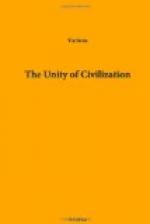And yet the drama of Spain is in all its most essential and intimate characteristics the same as that of England; represents on the one side the same overwhelming sense of the tragic conflicts of life, the same sense of the greatness, the splendour of human nature, which is most triumphant when most it seems to fail; and on the other side at least something of that exquisite, that almost unimaginable grace of the romantic comedy, of the world of Portia and Viola and Beatrice and Miranda. I do not think that the unity of the great art of Europe, the comparative insignificance of merely national characteristics and historical circumstances can find a more convincing illustration.
* * * * *
I could wish that I were able to deal adequately with the parallel movements of painting and sculpture during these centuries, but I have neither the capacity nor is there now the time to deal with them. This much only may be said, that the movement of these arts is very closely parallel during these centuries, from the fourteenth to the seventeenth, to that of literature. I cannot discuss the characteristics of mediaeval sculpture and painting, but I would remind you that the notion that these were merely conventional and abstract is just as mistaken as the notion that mediaeval literature deals only with conventions or allegories. It is of course obviously true that the ecclesiastical or religious purpose served by the greater part of the decorative art of the Middle Ages which has survived to us, limits and restrains its subjects and its forms. But no one who is at any pains to consider mediaeval sculpture and mosaic painting can fail to see that alongside of much which became conventional, and was fixed in what has been called the ‘Byzantine’ style, there is an immense amount of work both in sculpture and in mosaic which expresses the determination of the mediaeval artist to represent the world as he experienced and saw it, and that the main obstacle to the free expression of this spirit was not the acquiescence or satisfaction of the mediaeval artist in conventional forms, but the lack of technical dexterity. This will become evident to any one who will turn his attention, in studying the mosaics, from what are no doubt the somewhat conventional and hieratic figures of saints and angels to the realistic attempts to portray the stories of the Bible. And it will be clear to any one who will study, for instance, the sculpture of Wells or Amiens or Chartres that by the thirteenth century the artists were rapidly learning how to represent the world as they knew it, and something of its grace and beauty. If we say that the history of the plastic arts in Europe from the fourteenth to the seventeenth centuries is the history of the discovery and presentation first of reality, and then of reality as transformed by the highest imaginative conception of beauty, this must not be understood to mean that reality and beauty had been absent from those arts in the Middle Ages.




